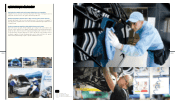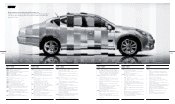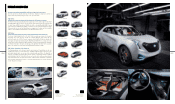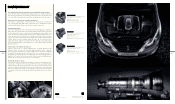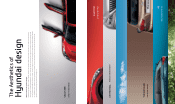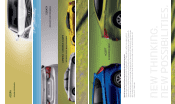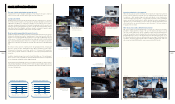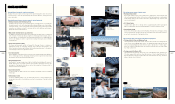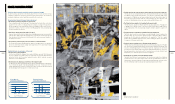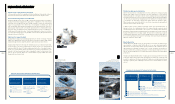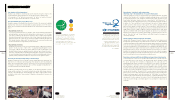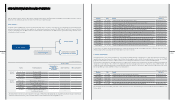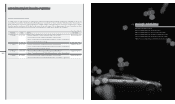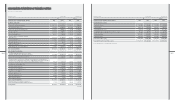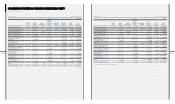Hyundai 2010 Annual Report Download - page 25
Download and view the complete annual report
Please find page 25 of the 2010 Hyundai annual report below. You can navigate through the pages in the report by either clicking on the pages listed below, or by using the keyword search tool below to find specific information within the annual report.
Global production network, marked by precious sweat and struggle
In order to produce cars suited to the lifestyle and preferences of each customer, we have
established a production system that stretches beyond national borders. At each factory
worldwide, Hyundai cars can be found that are specialized for local needs.
Korea factories, the world’s largest, best environment
+ Ulsan Factory, the largest single factory in the world
+ Ulsan is Hyundai’s main factory, made up of ve independent factory facilities on a 5 million
square-meter site, where over 34,000 employees produce an average of 5,400 vehicles
per day. In addition, it has a dedicated pier where three 50,000-ton ships can dock at once,
and has been called a “factory in a forest,” with 58,000 planted trees and cutting-edge
environmental protection facilities.
+ Asan Factory, where automotive quality is in the air
+ Asan is a fully self-sufcient factory that produces 300,000 large passenger cars annually for
strategic export. With a bright and refreshing factory environment centered on people and
their environment, this factory proves that the quality of the work environment translates to
the quality of the vehicle.
+ Jeonju Factory, world’s largest production center for commercial vehicles
+ The Jeonju factory, with an annual production capacity of 125,000 vehicles, is a specialized
factory for commercial vehicles, making trucks larger than 2.5 tons and medium-to-large
buses for 25 passengers or more.
Fantastic factories in each region of the world
+ The U.S. factory, pride of Alabama
+ In its rst year in 2005, the Alabama factory reached 10th place among 37 North American
factories for quality. Since 2009, it has been continuously selected as the North American
automotive factory with the greatest productivity, and in 2010 it achieved an annual
production record of 300,000 units.
+ The China factories, keeping pace with the world’s biggest market
+ The China factories have a total annual production capacity of 600,000, with the establishment
of a second factory capable of producing 300,000 units per year. To keep pace with the
rapidly expanding Chinese market, a third factory is under construction and will be nished
by 2012, bringing total China capacity to 1 million cars per year.
+ The India factories, the world’s best base camp for the production and sale of small cars
+ The India factories are integrated facilities that can independently handle functions ranging
from R&D to testing, manufacturing and sales. A second factory was built in 2008, raising
annual capacity to 600,000 cars per year, and India has become the production base for
the i10, the rst model exclusively made for overseas markets. The i10 is exported to 120
countries. In 2010, 600,480 vehicles were made in India and 603,819 were sold.
+ The Turkey factory, preparation for targeting the European market
+ The Turkey factory, expanded in March 2007 from an annual production of 60,000 units
to 100,000, is in a strategic location connected to Europe, Africa and the Middle East; by
localized manufacture of the Accent and i20, this plant contributes greatly to expansion of
exports.
+ The Czech factory, a beachhead for expanding European market share
+ The Czech plant, located in central Europe, exceeded 300,000 total units produced in
November 2010, only two years after production began in November 2008. In addition,
Hyundai was the rst automotive manufacturer to be awarded the “Start Plus” quality
award by the Czech Quality Award Association, further solidifying the plant as a beachhead
for expansion of European market share.
+ The Russia factory, stepping-stone to European market expansion
+ The Russia factory, which began mass production in 2011, has an annual capacity of 150,000
cars. This factory is staffed by skilled employees trained in Korea and the Czech Republic, and
focuses on strengthening designs to meet Russian local needs. In particular, we customized
the Solaris (Accent) for Russian market with stronger exibility and dynamism, in view of the
Russian driving culture, climate and roads. The Solaris has been selected as the Best Small
Car by Klaxon, one of Russia’s top three automotive magazines.
+ The Brazil factory, gateway to the Latin American market
+ The Brazil factory will serve as a gateway for the Latin American market by establishing
a production base in the region’s largest market. After the groundbreaking ceremony in
February 2011, the plant is planned to begin producing small passenger cars with a style
suited to the Brazilian market in 2012, greatly expanding Hyundai’s market share.
Korea factories
production performance
2010 annual production
(units: 1,000 vehicles)
Ulsan
Asan
Jeonju
Overseas factories
production performance
2010 annual production
(units: 1,000 vehicles)
U.S.
China
India
Turkey
Czech
Republic
1 Automation facilities at the St. Petersburg, Russia
2 Assembly line at factory in St. Petersburg, Russia


